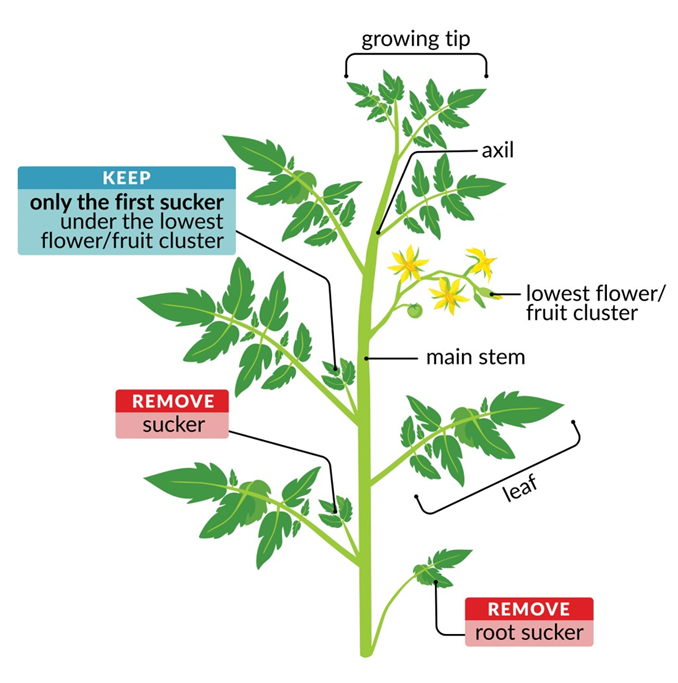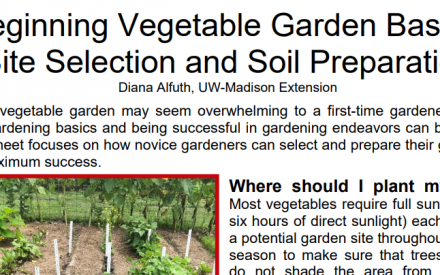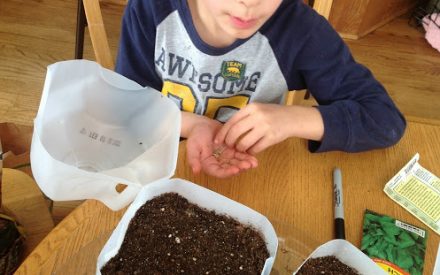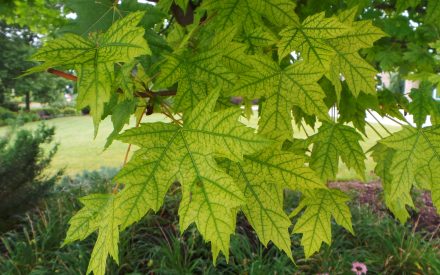By Claire Strader and Lisa Johnson, Extension Dane County
XHT1275
Revised: February 8, 2021
Tomatoes are a popular vegetable that many people grow in their home gardens. Pruning tomatoes can create stronger and healthier plants that will grow larger numbers of higher quality tomato fruits later into the growing season.

Which tomatoes should I prune? There are two broad categories of tomatoes: determinate and indeterminate. Determinate tomatoes grow to a certain size, then stop growing. Indeterminate tomatoes continue to grow throughout the growing season. Seed catalogues, seed packets or plant identification stakes will indicate which type of tomato you have. Prune indeterminate tomatoes only.
Why should I prune my tomatoes? Pruning indeterminate tomatoes improves fruit production by removing extra growth that diverts energy away from developing fruits. Removing extra growth redirects energy back to the fruits and reduces fruit shading, both of which will help fruits mature more quickly. Pruning also allows for more airflow within a plant, which reduces humidity and speeds the drying of any remaining leaves. This drier environment is less favorable for fungal and bacterial disease development. Removing the bottommost leaves of a tomato plant serves a similar purpose.
When should I prune my tomatoes? Start pruning in late June or early July when the first tomato flowers are open and easy to identify. Continue with a second and third pruning (as needed) every 10 to 14 days following the first pruning. Stop pruning one to two weeks before your expected first harvest to allow time for tomato plants to produce canopies that will protect fruits from sunscald (pale, injured areas caused by exposure to direct sun).
How should I prune tomato plants? Use the illustrations on this fact sheet as a guide. Identify the main stem of the plant, and locate any suckers. Suckers are branches that form in the leaf axils (the junctions between the true leaves and the main stem). Next, identify the lowest flower / fruit cluster on the plant (i.e., the flower / fruit cluster closest to the ground). Remove every sucker from the plant EXCEPT for the first one below the lowest flower / fruit cluster. That sucker is the strongest one on the plant and should be left to grow and bear fruit as a second stem.

Suckers may be small, especially early in the season, but remove them as soon as possible. Suckers left to grow will produce their own leaves, flowers, fruits, and even additional suckers, which will divert energy from tomato fruits produced on the primary and secondary stems. Also, during the growing season, watch for and remove any root suckers that form at the bases of plants.
Remove suckers by pinching them close to the stem using your thumb and index finger (if the suckers are small), or using scissors or hand pruners. Decontaminate your fingers by routinely washing your hands with soap and water or by using an alcohol-based hand sanitizer. Decontaminate scissors/pruners (both prior to pruning and between each plant) by treating them for at least 30 seconds with rubbing alcohol. Decontamination will help prevent the spread of disease-causing fungi, bacteria and viruses.
Download Article





 Beginning Vegetable Garden Basics: Site Selection and Soil Preparation
Beginning Vegetable Garden Basics: Site Selection and Soil Preparation Seed Starting
Seed Starting Reducing Soil pH
Reducing Soil pH Growing Vegetables at Home: Questions and Answers
Growing Vegetables at Home: Questions and Answers


